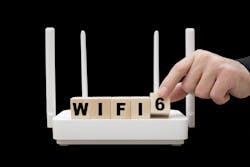Interoperability Will Drive IoT Innovation Across Industries in 2023
This article appeared in Microwaves & RF and has been published here with permission.
This article is part of our 2023 Electronic Design Technology Forecast issue and the TechXchange: Why Matter Matters.
What you’ll learn:
- The benefits of Wi-Fi 6 SoCs, which make it possible for devices to have a longer battery life and enhanced performance in high-density environments.
- The benefits of Matter that enable consumers to integrate devices with different ecosystems.
- The benefits of the Wi-SUN protocol, which supports smart cities that allow for utilities, municipalities, and other enterprises to deploy long-range, low-power wireless mesh networks.
As the IoT industry rapidly evolves with each year, we can expect a new array of possible applications in every sector. However, with technology innovation on the rise, the industry has quickly grown oversaturated with devices and networks, leading to challenges in meeting connectivity, capacity, efficiency, and performance needs.
On that front, Silicon Labs recently developed Wi-Fi 6 solutions, Matter over Wi-Fi 4 and 6 solutions, the FG25 SoC, and a Wi-SUN standards-based stack. These technologies provide ultra-low-power capability, integrate robust security to protect devices and customers against cyberattacks, and help users with faster IoT-device integration.
In the upcoming era of IoT, these connectivity achievements can address the fractured market, advance industrial and commercial industries, grow economies, and improve home and life applications.
Wi-Fi 6: Addressing Capacity Needs
Although Wi-Fi has been around for many years and is the most prevalent protocol available to consumers, the technology has yet to reach its full potential. Users are eager for connected devices with advanced visual, audio, and data-processing functions that they can easily control from their phones—and all of these features require more bandwidth and energy.
Because many Wi-Fi devices use the 2.4-GHz spectrum, the network is significantly crowded with these devices. Such oversaturation can cause poor performance, particularly in high-density areas.
As the next generation of Wi-Fi, Wi-Fi 6 has unique features such as OFDMA enabling a host of 2.4-GHz devices to coexist, alleviating the need to move to 5-GHz spectrum and support more applications. Still, designers need optimized SoCs for Wi-Fi 6 to create higher-performing, more energy-efficient products.
Addressing density challenges, the SiWx917 ultra-low-power Wi-Fi SoC is a fully integrated, single SoC with an accelerator for machine learning. It runs all wireless stacks, networking stacks, and user applications on the same chip, and offers interoperability with Matter. Other features include a high memory capacity and higher data rates as well as robust security. These types of SoCs will help speed time-to-market, reduce cost, and deploy new devices in residential, commercial, and industrial environments more rapidly.
Matter-Over-Wi-Fi and Matter-Over-Thread: Simplifying IoT Connection
Last year, the new Matter 1.0 standard was released by the Connectivity Standards Alliance, promising the convergence of the major IoT ecosystems and offering one wireless protocol to connect all IoT networks and devices.
Before Matter, building smart-home products was challenging due to the fractured market, and likewise, home setup could be difficult for consumers to manage. In the coming year, we’ll see the Matter standard improve interoperability across devices, ecosystems, and brands, simplifying the lives of device manufacturers and consumers, and significantly reducing time and costs for deploying devices.
Matter development solutions developed by Silicon Labs provide support for Matter-over-Wi-Fi, Matter-over-Thread, Bluetooth LE commissioning, as well as Matter bridges to 802.15.4, Zigbee, and Z-Wave. The 2.4 GHz wireless MG24 SoC with support for Bluetooth and Thread, and the Wi-Fi 6 SoC, SiWx917, feature ultra-low power capabilities and are central to the company’s Matter platform.
As designers and developers begin to have more leverage with building Matter-ready products, we’ll see many more Matter-certified products on the market and at work in our homes in the near future.
Wi-SUN: Enabling Smart Cities
More than ever, industrial and commercial industries are looking to IoT to build more scalable, safer, efficient, and sustainable infrastructure. Utility companies are beginning to consider how data from IoT devices can inform how to streamline and manage energy efficiency. City planners and municipal engineers are looking to connect streetlights, cameras, weather stations, utility transmission systems, parking systems, and more to extract the most benefits from municipal services.
Due to the steadily increasing number of city and smart utility applications, we’ll need flexible and versatile solutions for large-scale IoT wireless communication networks to support these applications.
Silicon Labs’ FG25 SoC for Wi-SUN, the world’s first open protocol for smart city and smart utility applications, will help simplify wireless connectivity for major community infrastructure. It’s designed to support long-range, low-power transmission that can broadcast data up to three kilometers in dense urban environments. It also maintains higher data rates, enabling the large networks needed by smart cities and increase their solution's performance.
The FG25 is built with sustainability in mind and optimized for low power and performance for network and connected devices. It’s also one of the first devices to be certified for FAN 1.1 PHY.
Wi-SUN SoCs will enable cities to monitor municipal assets in real-time, control when and where they need power, and allow residents to track their energy consumption.
We expect advances in sensor and wireless IoT technologies to continue paving the way for smart city innovation.
Looking Ahead to 2023
Last year was an exciting time to accelerate IoT achievements while the world reopened from the pandemic and sought new solutions. This year, we expect widespread interoperability, simplified device management, robust security, and seamless connectivity, as advances like Wi-Fi 6, Matter, and Wi-SUN represent only the beginning of new innovations in our homes, communities, and businesses.
About the Author
Ross Sabolcik
Senior Vice President and General Manager for Industrial and Commercial IoT Products, Silicon Labs
Ross Sabolcik leads Silicon Labs’ Industrial and Commercial IoT business unit. He oversees the delivery of connected, wireless solutions for industrial and commercial sectors including metering, industrial and building automation, commercial lighting, and connected retail applications.
Ross joined Silicon Labs in 1999 and holds a Master’s degree in computer and systems engineering from Rensselaer Polytechnic Institute and a Bachelor’s degree in electrical engineering from Penn State University. He currently serves on the executive committee for Austin Habitat for Humanity.



